Organization and Leadership: Making Sense of an Organization Analysis
VerifiedAdded on 2023/05/28
|16
|4127
|272
Essay
AI Summary
This essay provides an in-depth analysis of organizational management, focusing on the question of whether the management of organizations can be treated as a 'science.' It begins by defining organizations and their importance, then delves into the scientific management theory, also known as Taylorism, and its principles. The essay critiques Taylorism, highlighting its limitations and the exploitation of workers, while also introducing contrasting perspectives such as Theory X and Theory Y and providing examples of modern-day industry. The essay then explores modernism and postmodernism, contrasting their principles and impact on organizational practices. It also examines the issues and consequences of scientific management, including the exploitation of workers and the limitations of its approach. Furthermore, the essay includes the analysis of metaphors, cultural theories, ethical theories, consequential theories, and rule-based theories, linking them to the argument with Taylor's scientific method. Finally, it highlights the significance of recognizing workers and the evolution of management styles from scientific to more flexible and employee-centric approaches. The essay utilizes contemporary news events and personal examples to support the points made.
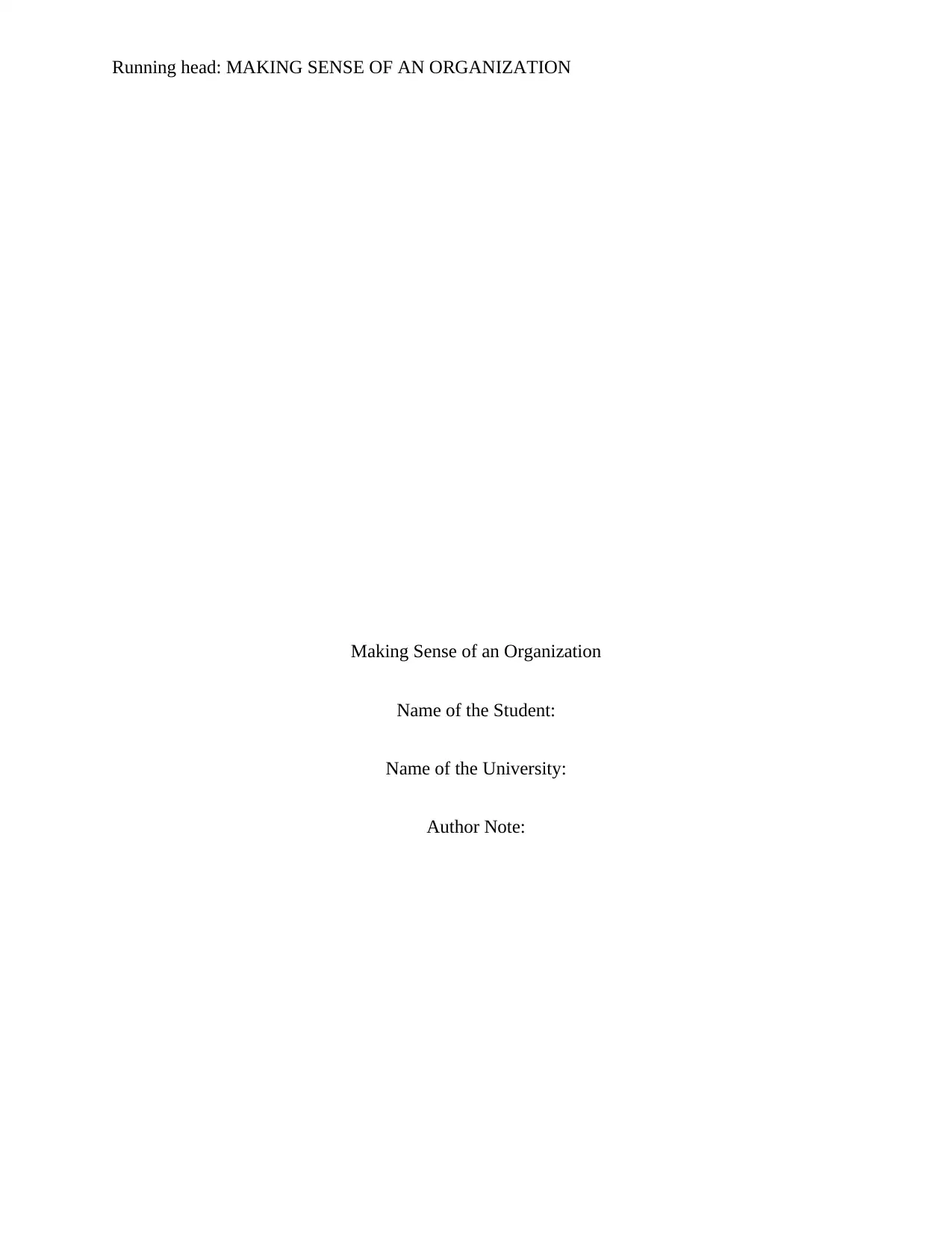
Running head: MAKING SENSE OF AN ORGANIZATION
Making Sense of an Organization
Name of the Student:
Name of the University:
Author Note:
Making Sense of an Organization
Name of the Student:
Name of the University:
Author Note:
Paraphrase This Document
Need a fresh take? Get an instant paraphrase of this document with our AI Paraphraser
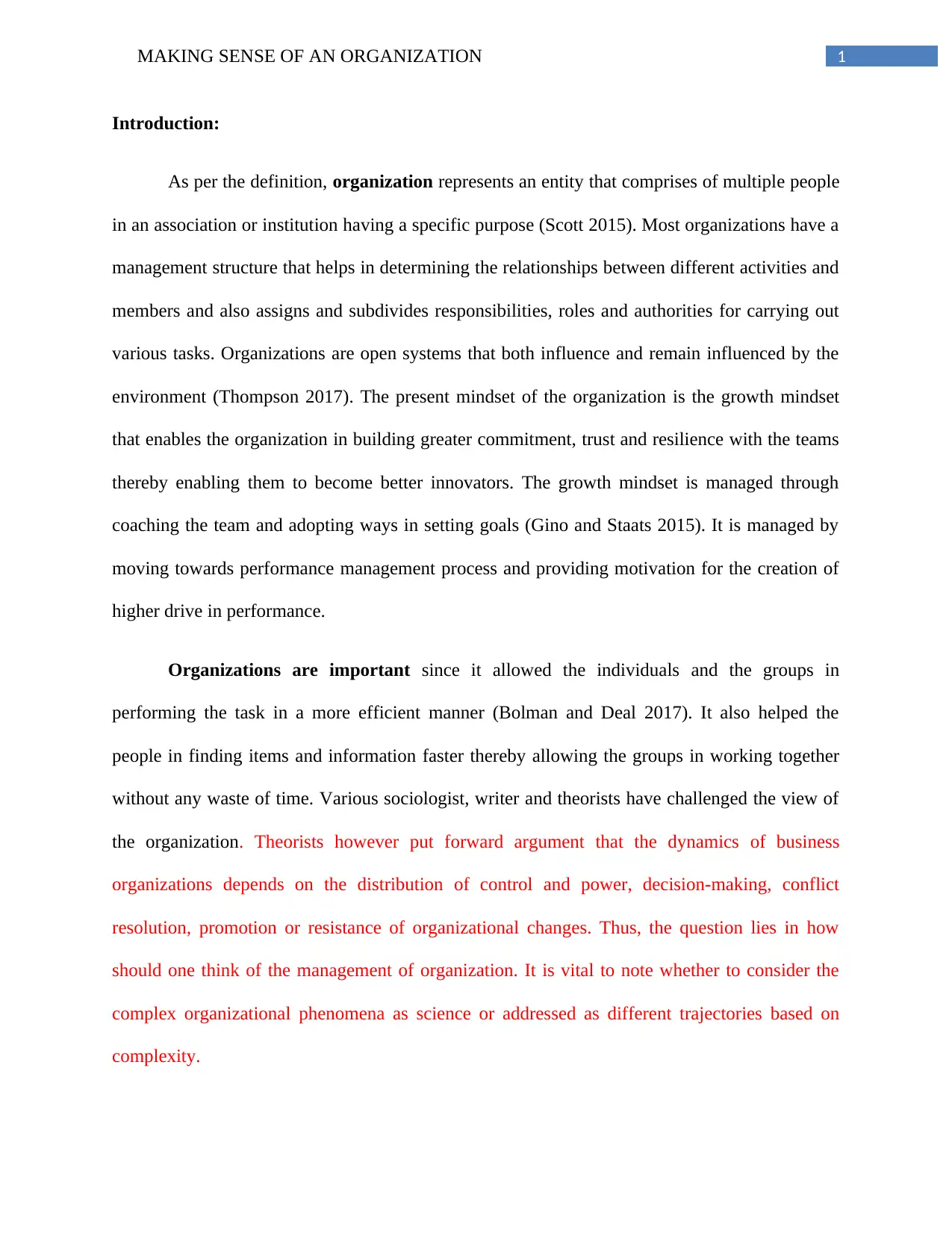
1MAKING SENSE OF AN ORGANIZATION
Introduction:
As per the definition, organization represents an entity that comprises of multiple people
in an association or institution having a specific purpose (Scott 2015). Most organizations have a
management structure that helps in determining the relationships between different activities and
members and also assigns and subdivides responsibilities, roles and authorities for carrying out
various tasks. Organizations are open systems that both influence and remain influenced by the
environment (Thompson 2017). The present mindset of the organization is the growth mindset
that enables the organization in building greater commitment, trust and resilience with the teams
thereby enabling them to become better innovators. The growth mindset is managed through
coaching the team and adopting ways in setting goals (Gino and Staats 2015). It is managed by
moving towards performance management process and providing motivation for the creation of
higher drive in performance.
Organizations are important since it allowed the individuals and the groups in
performing the task in a more efficient manner (Bolman and Deal 2017). It also helped the
people in finding items and information faster thereby allowing the groups in working together
without any waste of time. Various sociologist, writer and theorists have challenged the view of
the organization. Theorists however put forward argument that the dynamics of business
organizations depends on the distribution of control and power, decision-making, conflict
resolution, promotion or resistance of organizational changes. Thus, the question lies in how
should one think of the management of organization. It is vital to note whether to consider the
complex organizational phenomena as science or addressed as different trajectories based on
complexity.
Introduction:
As per the definition, organization represents an entity that comprises of multiple people
in an association or institution having a specific purpose (Scott 2015). Most organizations have a
management structure that helps in determining the relationships between different activities and
members and also assigns and subdivides responsibilities, roles and authorities for carrying out
various tasks. Organizations are open systems that both influence and remain influenced by the
environment (Thompson 2017). The present mindset of the organization is the growth mindset
that enables the organization in building greater commitment, trust and resilience with the teams
thereby enabling them to become better innovators. The growth mindset is managed through
coaching the team and adopting ways in setting goals (Gino and Staats 2015). It is managed by
moving towards performance management process and providing motivation for the creation of
higher drive in performance.
Organizations are important since it allowed the individuals and the groups in
performing the task in a more efficient manner (Bolman and Deal 2017). It also helped the
people in finding items and information faster thereby allowing the groups in working together
without any waste of time. Various sociologist, writer and theorists have challenged the view of
the organization. Theorists however put forward argument that the dynamics of business
organizations depends on the distribution of control and power, decision-making, conflict
resolution, promotion or resistance of organizational changes. Thus, the question lies in how
should one think of the management of organization. It is vital to note whether to consider the
complex organizational phenomena as science or addressed as different trajectories based on
complexity.
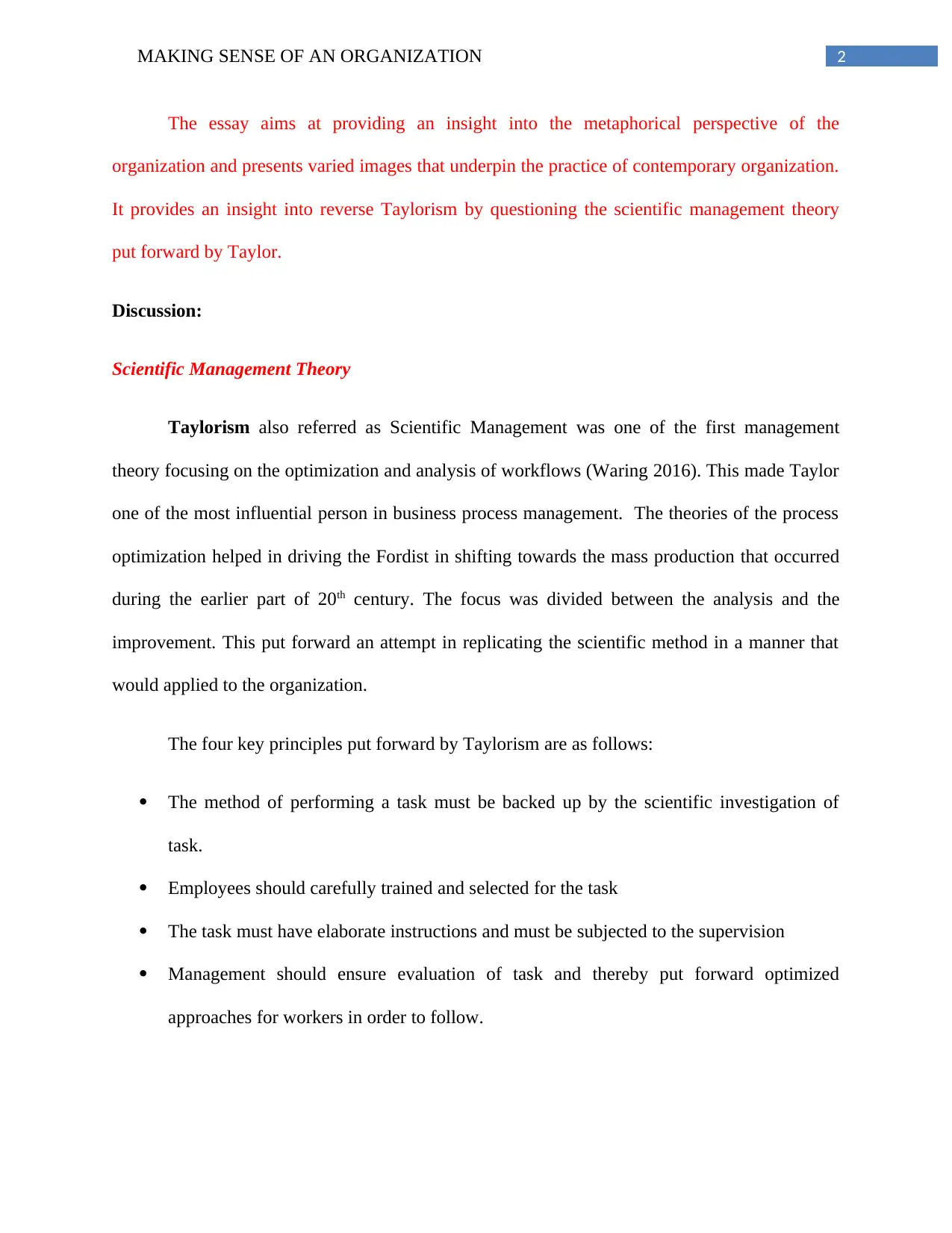
2MAKING SENSE OF AN ORGANIZATION
The essay aims at providing an insight into the metaphorical perspective of the
organization and presents varied images that underpin the practice of contemporary organization.
It provides an insight into reverse Taylorism by questioning the scientific management theory
put forward by Taylor.
Discussion:
Scientific Management Theory
Taylorism also referred as Scientific Management was one of the first management
theory focusing on the optimization and analysis of workflows (Waring 2016). This made Taylor
one of the most influential person in business process management. The theories of the process
optimization helped in driving the Fordist in shifting towards the mass production that occurred
during the earlier part of 20th century. The focus was divided between the analysis and the
improvement. This put forward an attempt in replicating the scientific method in a manner that
would applied to the organization.
The four key principles put forward by Taylorism are as follows:
The method of performing a task must be backed up by the scientific investigation of
task.
Employees should carefully trained and selected for the task
The task must have elaborate instructions and must be subjected to the supervision
Management should ensure evaluation of task and thereby put forward optimized
approaches for workers in order to follow.
The essay aims at providing an insight into the metaphorical perspective of the
organization and presents varied images that underpin the practice of contemporary organization.
It provides an insight into reverse Taylorism by questioning the scientific management theory
put forward by Taylor.
Discussion:
Scientific Management Theory
Taylorism also referred as Scientific Management was one of the first management
theory focusing on the optimization and analysis of workflows (Waring 2016). This made Taylor
one of the most influential person in business process management. The theories of the process
optimization helped in driving the Fordist in shifting towards the mass production that occurred
during the earlier part of 20th century. The focus was divided between the analysis and the
improvement. This put forward an attempt in replicating the scientific method in a manner that
would applied to the organization.
The four key principles put forward by Taylorism are as follows:
The method of performing a task must be backed up by the scientific investigation of
task.
Employees should carefully trained and selected for the task
The task must have elaborate instructions and must be subjected to the supervision
Management should ensure evaluation of task and thereby put forward optimized
approaches for workers in order to follow.
⊘ This is a preview!⊘
Do you want full access?
Subscribe today to unlock all pages.

Trusted by 1+ million students worldwide
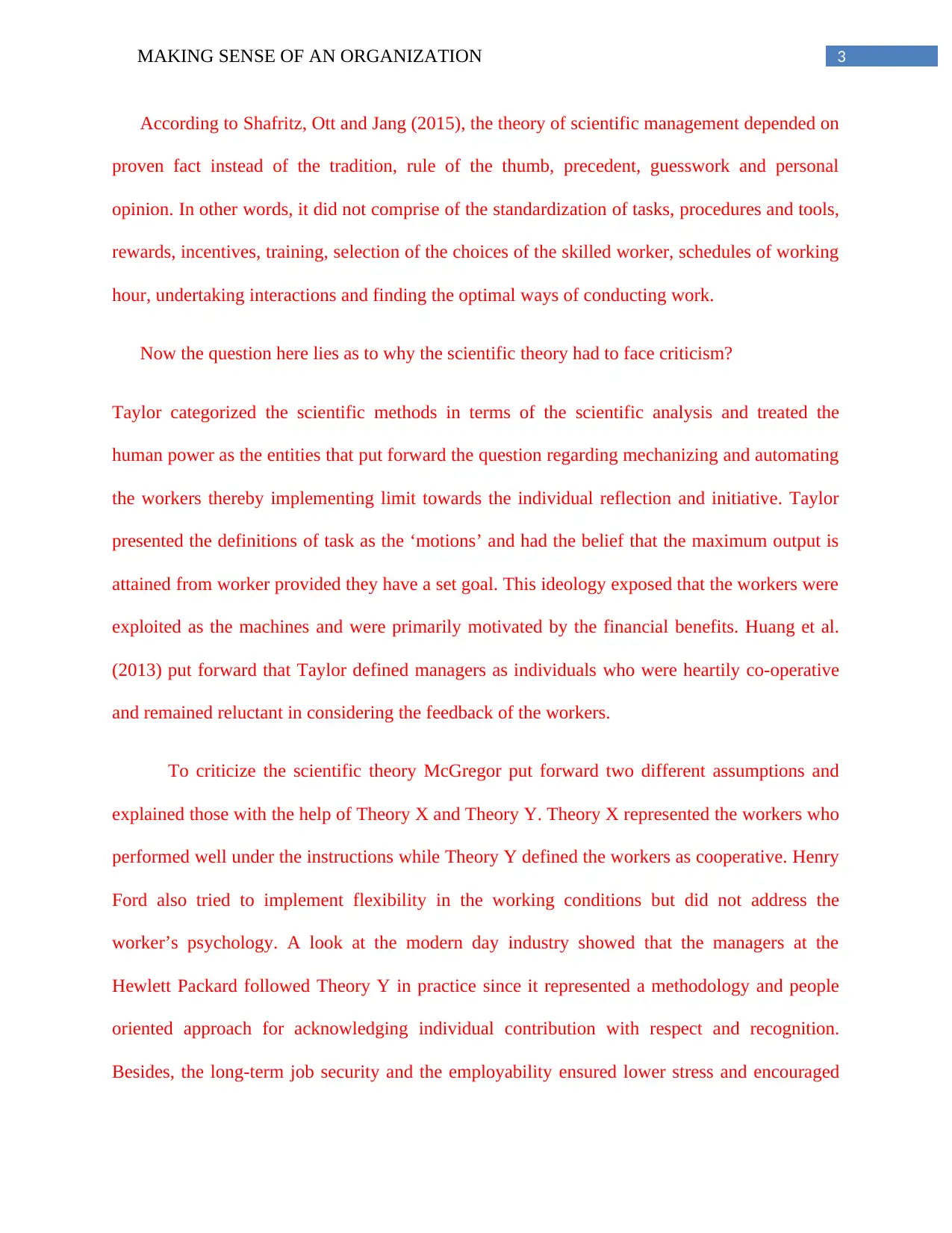
3MAKING SENSE OF AN ORGANIZATION
According to Shafritz, Ott and Jang (2015), the theory of scientific management depended on
proven fact instead of the tradition, rule of the thumb, precedent, guesswork and personal
opinion. In other words, it did not comprise of the standardization of tasks, procedures and tools,
rewards, incentives, training, selection of the choices of the skilled worker, schedules of working
hour, undertaking interactions and finding the optimal ways of conducting work.
Now the question here lies as to why the scientific theory had to face criticism?
Taylor categorized the scientific methods in terms of the scientific analysis and treated the
human power as the entities that put forward the question regarding mechanizing and automating
the workers thereby implementing limit towards the individual reflection and initiative. Taylor
presented the definitions of task as the ‘motions’ and had the belief that the maximum output is
attained from worker provided they have a set goal. This ideology exposed that the workers were
exploited as the machines and were primarily motivated by the financial benefits. Huang et al.
(2013) put forward that Taylor defined managers as individuals who were heartily co-operative
and remained reluctant in considering the feedback of the workers.
To criticize the scientific theory McGregor put forward two different assumptions and
explained those with the help of Theory X and Theory Y. Theory X represented the workers who
performed well under the instructions while Theory Y defined the workers as cooperative. Henry
Ford also tried to implement flexibility in the working conditions but did not address the
worker’s psychology. A look at the modern day industry showed that the managers at the
Hewlett Packard followed Theory Y in practice since it represented a methodology and people
oriented approach for acknowledging individual contribution with respect and recognition.
Besides, the long-term job security and the employability ensured lower stress and encouraged
According to Shafritz, Ott and Jang (2015), the theory of scientific management depended on
proven fact instead of the tradition, rule of the thumb, precedent, guesswork and personal
opinion. In other words, it did not comprise of the standardization of tasks, procedures and tools,
rewards, incentives, training, selection of the choices of the skilled worker, schedules of working
hour, undertaking interactions and finding the optimal ways of conducting work.
Now the question here lies as to why the scientific theory had to face criticism?
Taylor categorized the scientific methods in terms of the scientific analysis and treated the
human power as the entities that put forward the question regarding mechanizing and automating
the workers thereby implementing limit towards the individual reflection and initiative. Taylor
presented the definitions of task as the ‘motions’ and had the belief that the maximum output is
attained from worker provided they have a set goal. This ideology exposed that the workers were
exploited as the machines and were primarily motivated by the financial benefits. Huang et al.
(2013) put forward that Taylor defined managers as individuals who were heartily co-operative
and remained reluctant in considering the feedback of the workers.
To criticize the scientific theory McGregor put forward two different assumptions and
explained those with the help of Theory X and Theory Y. Theory X represented the workers who
performed well under the instructions while Theory Y defined the workers as cooperative. Henry
Ford also tried to implement flexibility in the working conditions but did not address the
worker’s psychology. A look at the modern day industry showed that the managers at the
Hewlett Packard followed Theory Y in practice since it represented a methodology and people
oriented approach for acknowledging individual contribution with respect and recognition.
Besides, the long-term job security and the employability ensured lower stress and encouraged
Paraphrase This Document
Need a fresh take? Get an instant paraphrase of this document with our AI Paraphraser
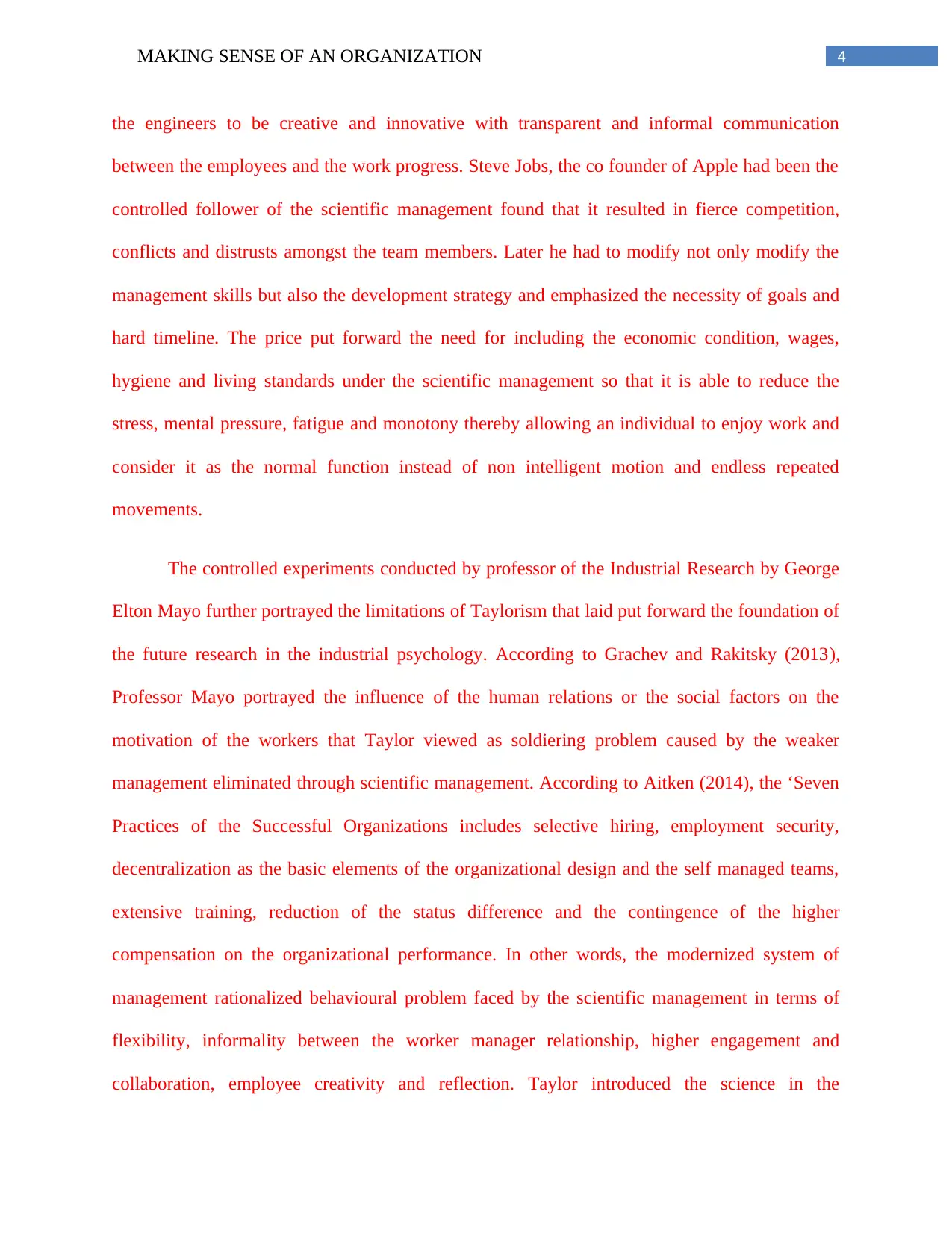
4MAKING SENSE OF AN ORGANIZATION
the engineers to be creative and innovative with transparent and informal communication
between the employees and the work progress. Steve Jobs, the co founder of Apple had been the
controlled follower of the scientific management found that it resulted in fierce competition,
conflicts and distrusts amongst the team members. Later he had to modify not only modify the
management skills but also the development strategy and emphasized the necessity of goals and
hard timeline. The price put forward the need for including the economic condition, wages,
hygiene and living standards under the scientific management so that it is able to reduce the
stress, mental pressure, fatigue and monotony thereby allowing an individual to enjoy work and
consider it as the normal function instead of non intelligent motion and endless repeated
movements.
The controlled experiments conducted by professor of the Industrial Research by George
Elton Mayo further portrayed the limitations of Taylorism that laid put forward the foundation of
the future research in the industrial psychology. According to Grachev and Rakitsky (2013),
Professor Mayo portrayed the influence of the human relations or the social factors on the
motivation of the workers that Taylor viewed as soldiering problem caused by the weaker
management eliminated through scientific management. According to Aitken (2014), the ‘Seven
Practices of the Successful Organizations includes selective hiring, employment security,
decentralization as the basic elements of the organizational design and the self managed teams,
extensive training, reduction of the status difference and the contingence of the higher
compensation on the organizational performance. In other words, the modernized system of
management rationalized behavioural problem faced by the scientific management in terms of
flexibility, informality between the worker manager relationship, higher engagement and
collaboration, employee creativity and reflection. Taylor introduced the science in the
the engineers to be creative and innovative with transparent and informal communication
between the employees and the work progress. Steve Jobs, the co founder of Apple had been the
controlled follower of the scientific management found that it resulted in fierce competition,
conflicts and distrusts amongst the team members. Later he had to modify not only modify the
management skills but also the development strategy and emphasized the necessity of goals and
hard timeline. The price put forward the need for including the economic condition, wages,
hygiene and living standards under the scientific management so that it is able to reduce the
stress, mental pressure, fatigue and monotony thereby allowing an individual to enjoy work and
consider it as the normal function instead of non intelligent motion and endless repeated
movements.
The controlled experiments conducted by professor of the Industrial Research by George
Elton Mayo further portrayed the limitations of Taylorism that laid put forward the foundation of
the future research in the industrial psychology. According to Grachev and Rakitsky (2013),
Professor Mayo portrayed the influence of the human relations or the social factors on the
motivation of the workers that Taylor viewed as soldiering problem caused by the weaker
management eliminated through scientific management. According to Aitken (2014), the ‘Seven
Practices of the Successful Organizations includes selective hiring, employment security,
decentralization as the basic elements of the organizational design and the self managed teams,
extensive training, reduction of the status difference and the contingence of the higher
compensation on the organizational performance. In other words, the modernized system of
management rationalized behavioural problem faced by the scientific management in terms of
flexibility, informality between the worker manager relationship, higher engagement and
collaboration, employee creativity and reflection. Taylor introduced the science in the
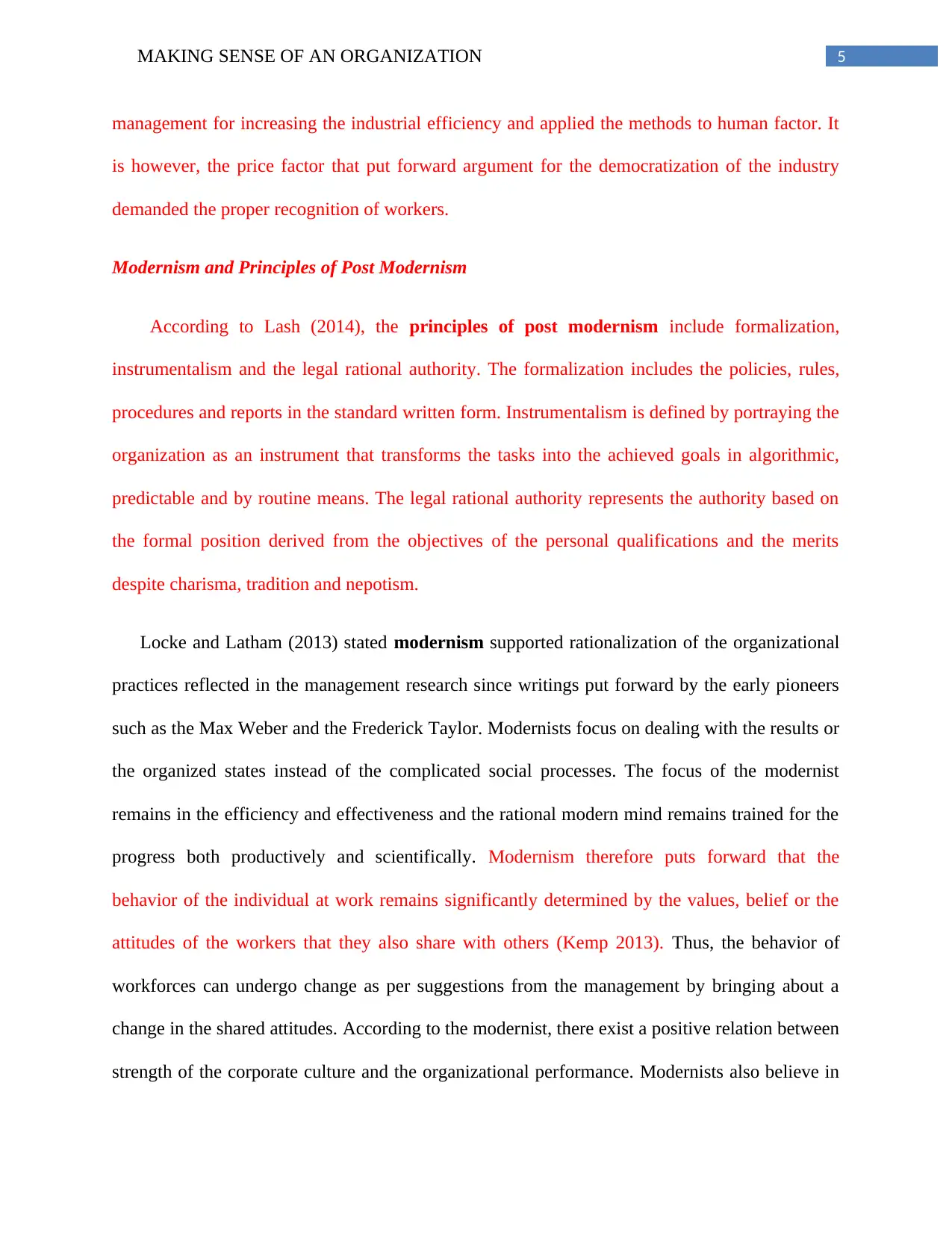
5MAKING SENSE OF AN ORGANIZATION
management for increasing the industrial efficiency and applied the methods to human factor. It
is however, the price factor that put forward argument for the democratization of the industry
demanded the proper recognition of workers.
Modernism and Principles of Post Modernism
According to Lash (2014), the principles of post modernism include formalization,
instrumentalism and the legal rational authority. The formalization includes the policies, rules,
procedures and reports in the standard written form. Instrumentalism is defined by portraying the
organization as an instrument that transforms the tasks into the achieved goals in algorithmic,
predictable and by routine means. The legal rational authority represents the authority based on
the formal position derived from the objectives of the personal qualifications and the merits
despite charisma, tradition and nepotism.
Locke and Latham (2013) stated modernism supported rationalization of the organizational
practices reflected in the management research since writings put forward by the early pioneers
such as the Max Weber and the Frederick Taylor. Modernists focus on dealing with the results or
the organized states instead of the complicated social processes. The focus of the modernist
remains in the efficiency and effectiveness and the rational modern mind remains trained for the
progress both productively and scientifically. Modernism therefore puts forward that the
behavior of the individual at work remains significantly determined by the values, belief or the
attitudes of the workers that they also share with others (Kemp 2013). Thus, the behavior of
workforces can undergo change as per suggestions from the management by bringing about a
change in the shared attitudes. According to the modernist, there exist a positive relation between
strength of the corporate culture and the organizational performance. Modernists also believe in
management for increasing the industrial efficiency and applied the methods to human factor. It
is however, the price factor that put forward argument for the democratization of the industry
demanded the proper recognition of workers.
Modernism and Principles of Post Modernism
According to Lash (2014), the principles of post modernism include formalization,
instrumentalism and the legal rational authority. The formalization includes the policies, rules,
procedures and reports in the standard written form. Instrumentalism is defined by portraying the
organization as an instrument that transforms the tasks into the achieved goals in algorithmic,
predictable and by routine means. The legal rational authority represents the authority based on
the formal position derived from the objectives of the personal qualifications and the merits
despite charisma, tradition and nepotism.
Locke and Latham (2013) stated modernism supported rationalization of the organizational
practices reflected in the management research since writings put forward by the early pioneers
such as the Max Weber and the Frederick Taylor. Modernists focus on dealing with the results or
the organized states instead of the complicated social processes. The focus of the modernist
remains in the efficiency and effectiveness and the rational modern mind remains trained for the
progress both productively and scientifically. Modernism therefore puts forward that the
behavior of the individual at work remains significantly determined by the values, belief or the
attitudes of the workers that they also share with others (Kemp 2013). Thus, the behavior of
workforces can undergo change as per suggestions from the management by bringing about a
change in the shared attitudes. According to the modernist, there exist a positive relation between
strength of the corporate culture and the organizational performance. Modernists also believe in
⊘ This is a preview!⊘
Do you want full access?
Subscribe today to unlock all pages.

Trusted by 1+ million students worldwide
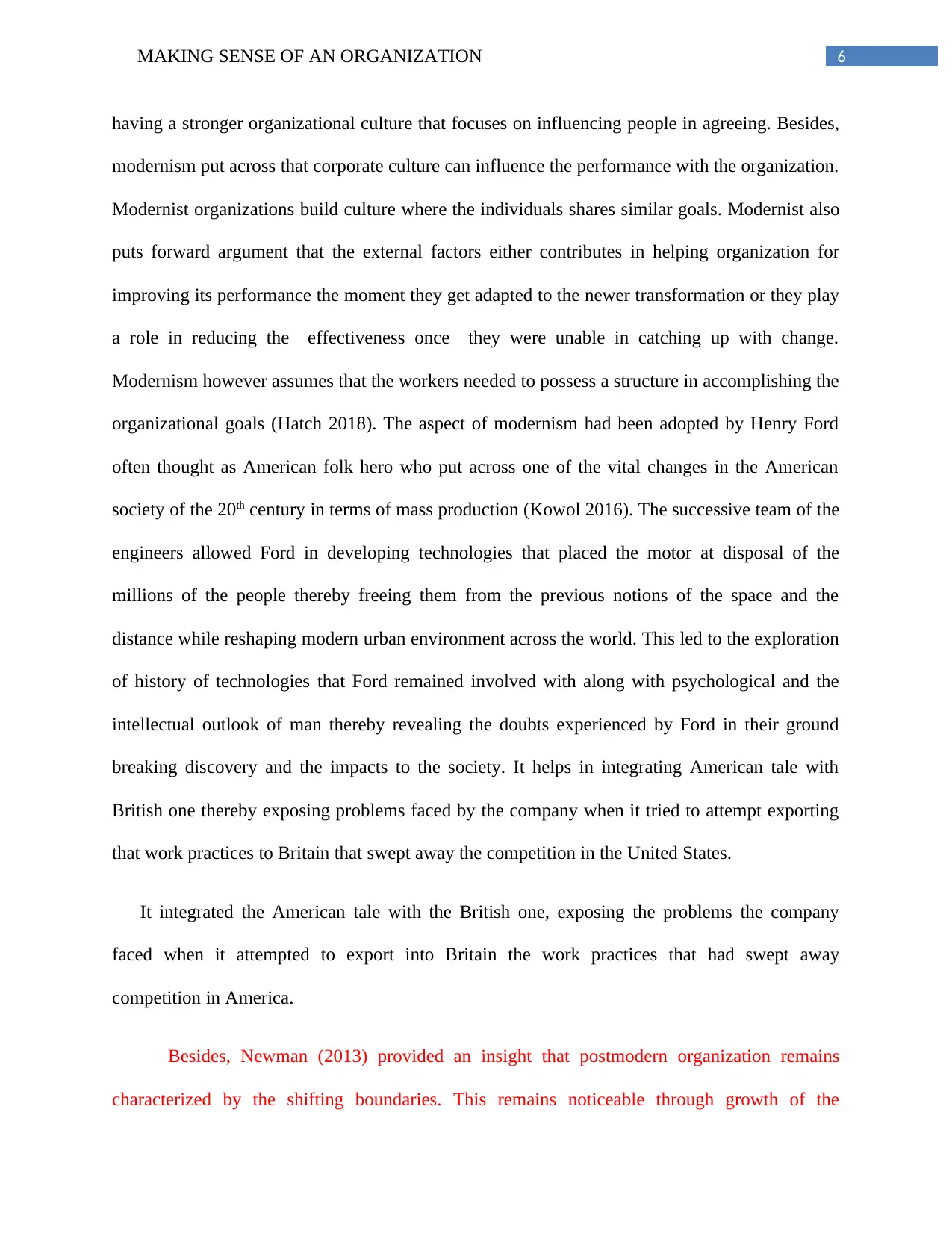
6MAKING SENSE OF AN ORGANIZATION
having a stronger organizational culture that focuses on influencing people in agreeing. Besides,
modernism put across that corporate culture can influence the performance with the organization.
Modernist organizations build culture where the individuals shares similar goals. Modernist also
puts forward argument that the external factors either contributes in helping organization for
improving its performance the moment they get adapted to the newer transformation or they play
a role in reducing the effectiveness once they were unable in catching up with change.
Modernism however assumes that the workers needed to possess a structure in accomplishing the
organizational goals (Hatch 2018). The aspect of modernism had been adopted by Henry Ford
often thought as American folk hero who put across one of the vital changes in the American
society of the 20th century in terms of mass production (Kowol 2016). The successive team of the
engineers allowed Ford in developing technologies that placed the motor at disposal of the
millions of the people thereby freeing them from the previous notions of the space and the
distance while reshaping modern urban environment across the world. This led to the exploration
of history of technologies that Ford remained involved with along with psychological and the
intellectual outlook of man thereby revealing the doubts experienced by Ford in their ground
breaking discovery and the impacts to the society. It helps in integrating American tale with
British one thereby exposing problems faced by the company when it tried to attempt exporting
that work practices to Britain that swept away the competition in the United States.
It integrated the American tale with the British one, exposing the problems the company
faced when it attempted to export into Britain the work practices that had swept away
competition in America.
Besides, Newman (2013) provided an insight that postmodern organization remains
characterized by the shifting boundaries. This remains noticeable through growth of the
having a stronger organizational culture that focuses on influencing people in agreeing. Besides,
modernism put across that corporate culture can influence the performance with the organization.
Modernist organizations build culture where the individuals shares similar goals. Modernist also
puts forward argument that the external factors either contributes in helping organization for
improving its performance the moment they get adapted to the newer transformation or they play
a role in reducing the effectiveness once they were unable in catching up with change.
Modernism however assumes that the workers needed to possess a structure in accomplishing the
organizational goals (Hatch 2018). The aspect of modernism had been adopted by Henry Ford
often thought as American folk hero who put across one of the vital changes in the American
society of the 20th century in terms of mass production (Kowol 2016). The successive team of the
engineers allowed Ford in developing technologies that placed the motor at disposal of the
millions of the people thereby freeing them from the previous notions of the space and the
distance while reshaping modern urban environment across the world. This led to the exploration
of history of technologies that Ford remained involved with along with psychological and the
intellectual outlook of man thereby revealing the doubts experienced by Ford in their ground
breaking discovery and the impacts to the society. It helps in integrating American tale with
British one thereby exposing problems faced by the company when it tried to attempt exporting
that work practices to Britain that swept away the competition in the United States.
It integrated the American tale with the British one, exposing the problems the company
faced when it attempted to export into Britain the work practices that had swept away
competition in America.
Besides, Newman (2013) provided an insight that postmodern organization remains
characterized by the shifting boundaries. This remains noticeable through growth of the
Paraphrase This Document
Need a fresh take? Get an instant paraphrase of this document with our AI Paraphraser
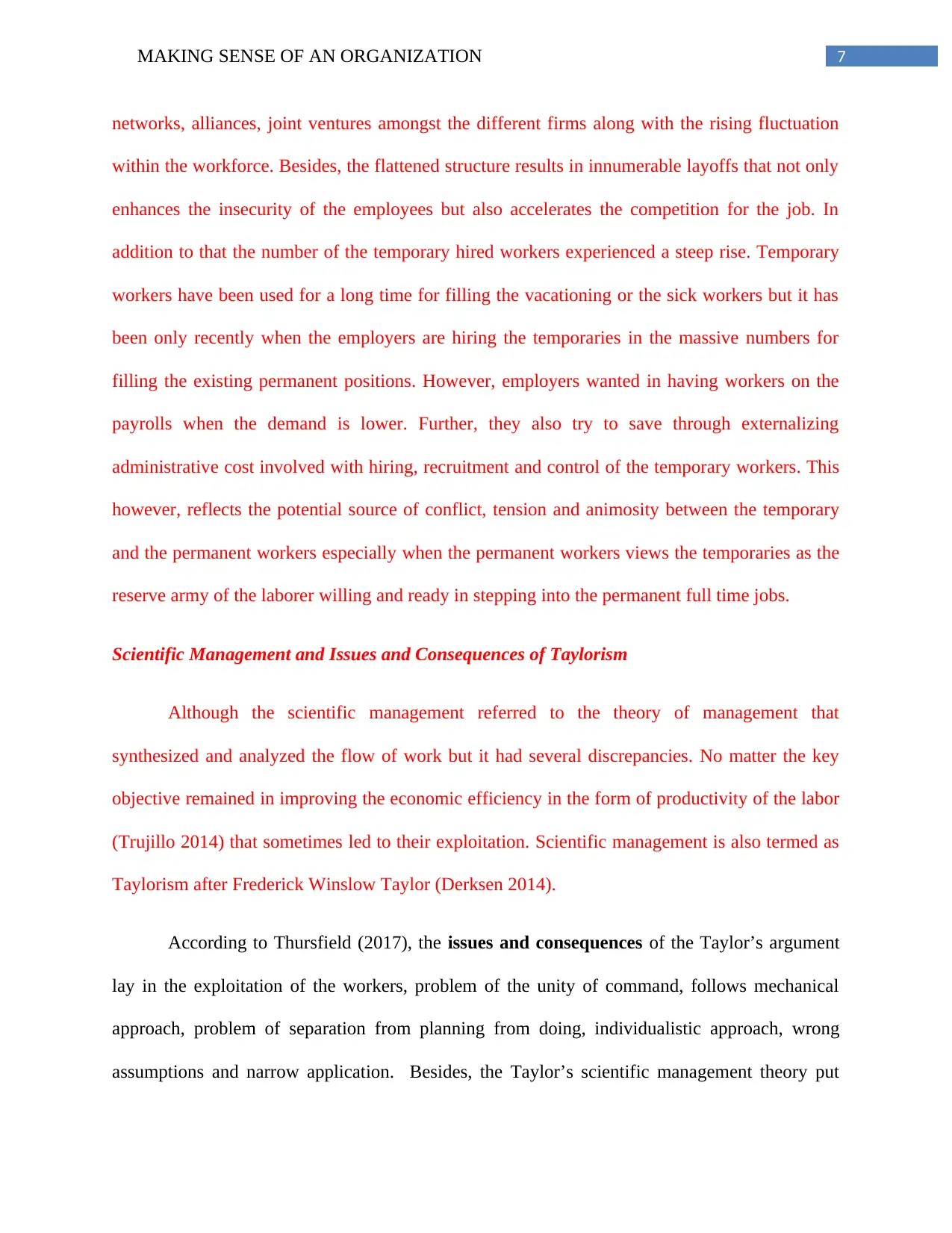
7MAKING SENSE OF AN ORGANIZATION
networks, alliances, joint ventures amongst the different firms along with the rising fluctuation
within the workforce. Besides, the flattened structure results in innumerable layoffs that not only
enhances the insecurity of the employees but also accelerates the competition for the job. In
addition to that the number of the temporary hired workers experienced a steep rise. Temporary
workers have been used for a long time for filling the vacationing or the sick workers but it has
been only recently when the employers are hiring the temporaries in the massive numbers for
filling the existing permanent positions. However, employers wanted in having workers on the
payrolls when the demand is lower. Further, they also try to save through externalizing
administrative cost involved with hiring, recruitment and control of the temporary workers. This
however, reflects the potential source of conflict, tension and animosity between the temporary
and the permanent workers especially when the permanent workers views the temporaries as the
reserve army of the laborer willing and ready in stepping into the permanent full time jobs.
Scientific Management and Issues and Consequences of Taylorism
Although the scientific management referred to the theory of management that
synthesized and analyzed the flow of work but it had several discrepancies. No matter the key
objective remained in improving the economic efficiency in the form of productivity of the labor
(Trujillo 2014) that sometimes led to their exploitation. Scientific management is also termed as
Taylorism after Frederick Winslow Taylor (Derksen 2014).
According to Thursfield (2017), the issues and consequences of the Taylor’s argument
lay in the exploitation of the workers, problem of the unity of command, follows mechanical
approach, problem of separation from planning from doing, individualistic approach, wrong
assumptions and narrow application. Besides, the Taylor’s scientific management theory put
networks, alliances, joint ventures amongst the different firms along with the rising fluctuation
within the workforce. Besides, the flattened structure results in innumerable layoffs that not only
enhances the insecurity of the employees but also accelerates the competition for the job. In
addition to that the number of the temporary hired workers experienced a steep rise. Temporary
workers have been used for a long time for filling the vacationing or the sick workers but it has
been only recently when the employers are hiring the temporaries in the massive numbers for
filling the existing permanent positions. However, employers wanted in having workers on the
payrolls when the demand is lower. Further, they also try to save through externalizing
administrative cost involved with hiring, recruitment and control of the temporary workers. This
however, reflects the potential source of conflict, tension and animosity between the temporary
and the permanent workers especially when the permanent workers views the temporaries as the
reserve army of the laborer willing and ready in stepping into the permanent full time jobs.
Scientific Management and Issues and Consequences of Taylorism
Although the scientific management referred to the theory of management that
synthesized and analyzed the flow of work but it had several discrepancies. No matter the key
objective remained in improving the economic efficiency in the form of productivity of the labor
(Trujillo 2014) that sometimes led to their exploitation. Scientific management is also termed as
Taylorism after Frederick Winslow Taylor (Derksen 2014).
According to Thursfield (2017), the issues and consequences of the Taylor’s argument
lay in the exploitation of the workers, problem of the unity of command, follows mechanical
approach, problem of separation from planning from doing, individualistic approach, wrong
assumptions and narrow application. Besides, the Taylor’s scientific management theory put
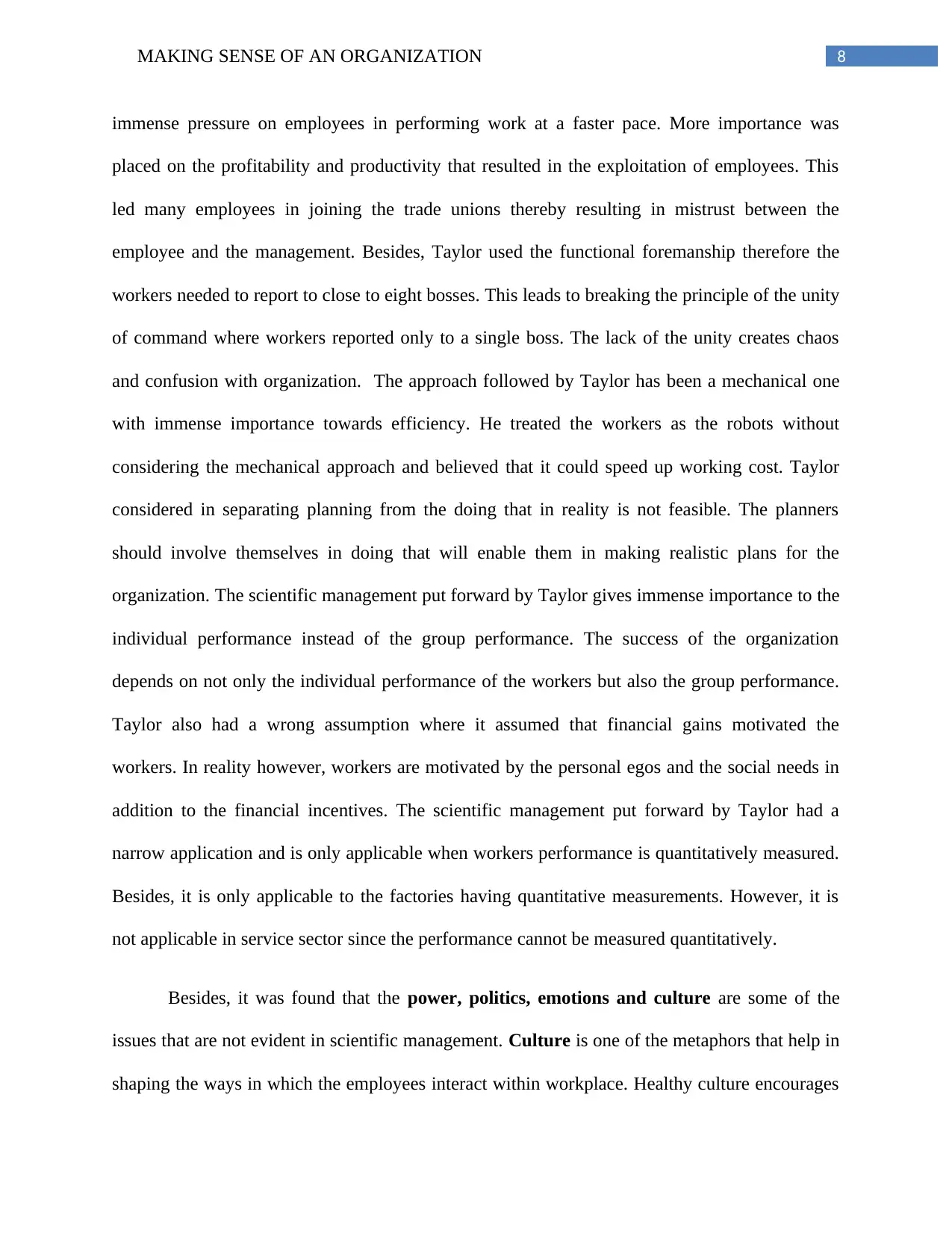
8MAKING SENSE OF AN ORGANIZATION
immense pressure on employees in performing work at a faster pace. More importance was
placed on the profitability and productivity that resulted in the exploitation of employees. This
led many employees in joining the trade unions thereby resulting in mistrust between the
employee and the management. Besides, Taylor used the functional foremanship therefore the
workers needed to report to close to eight bosses. This leads to breaking the principle of the unity
of command where workers reported only to a single boss. The lack of the unity creates chaos
and confusion with organization. The approach followed by Taylor has been a mechanical one
with immense importance towards efficiency. He treated the workers as the robots without
considering the mechanical approach and believed that it could speed up working cost. Taylor
considered in separating planning from the doing that in reality is not feasible. The planners
should involve themselves in doing that will enable them in making realistic plans for the
organization. The scientific management put forward by Taylor gives immense importance to the
individual performance instead of the group performance. The success of the organization
depends on not only the individual performance of the workers but also the group performance.
Taylor also had a wrong assumption where it assumed that financial gains motivated the
workers. In reality however, workers are motivated by the personal egos and the social needs in
addition to the financial incentives. The scientific management put forward by Taylor had a
narrow application and is only applicable when workers performance is quantitatively measured.
Besides, it is only applicable to the factories having quantitative measurements. However, it is
not applicable in service sector since the performance cannot be measured quantitatively.
Besides, it was found that the power, politics, emotions and culture are some of the
issues that are not evident in scientific management. Culture is one of the metaphors that help in
shaping the ways in which the employees interact within workplace. Healthy culture encourages
immense pressure on employees in performing work at a faster pace. More importance was
placed on the profitability and productivity that resulted in the exploitation of employees. This
led many employees in joining the trade unions thereby resulting in mistrust between the
employee and the management. Besides, Taylor used the functional foremanship therefore the
workers needed to report to close to eight bosses. This leads to breaking the principle of the unity
of command where workers reported only to a single boss. The lack of the unity creates chaos
and confusion with organization. The approach followed by Taylor has been a mechanical one
with immense importance towards efficiency. He treated the workers as the robots without
considering the mechanical approach and believed that it could speed up working cost. Taylor
considered in separating planning from the doing that in reality is not feasible. The planners
should involve themselves in doing that will enable them in making realistic plans for the
organization. The scientific management put forward by Taylor gives immense importance to the
individual performance instead of the group performance. The success of the organization
depends on not only the individual performance of the workers but also the group performance.
Taylor also had a wrong assumption where it assumed that financial gains motivated the
workers. In reality however, workers are motivated by the personal egos and the social needs in
addition to the financial incentives. The scientific management put forward by Taylor had a
narrow application and is only applicable when workers performance is quantitatively measured.
Besides, it is only applicable to the factories having quantitative measurements. However, it is
not applicable in service sector since the performance cannot be measured quantitatively.
Besides, it was found that the power, politics, emotions and culture are some of the
issues that are not evident in scientific management. Culture is one of the metaphors that help in
shaping the ways in which the employees interact within workplace. Healthy culture encourages
⊘ This is a preview!⊘
Do you want full access?
Subscribe today to unlock all pages.

Trusted by 1+ million students worldwide
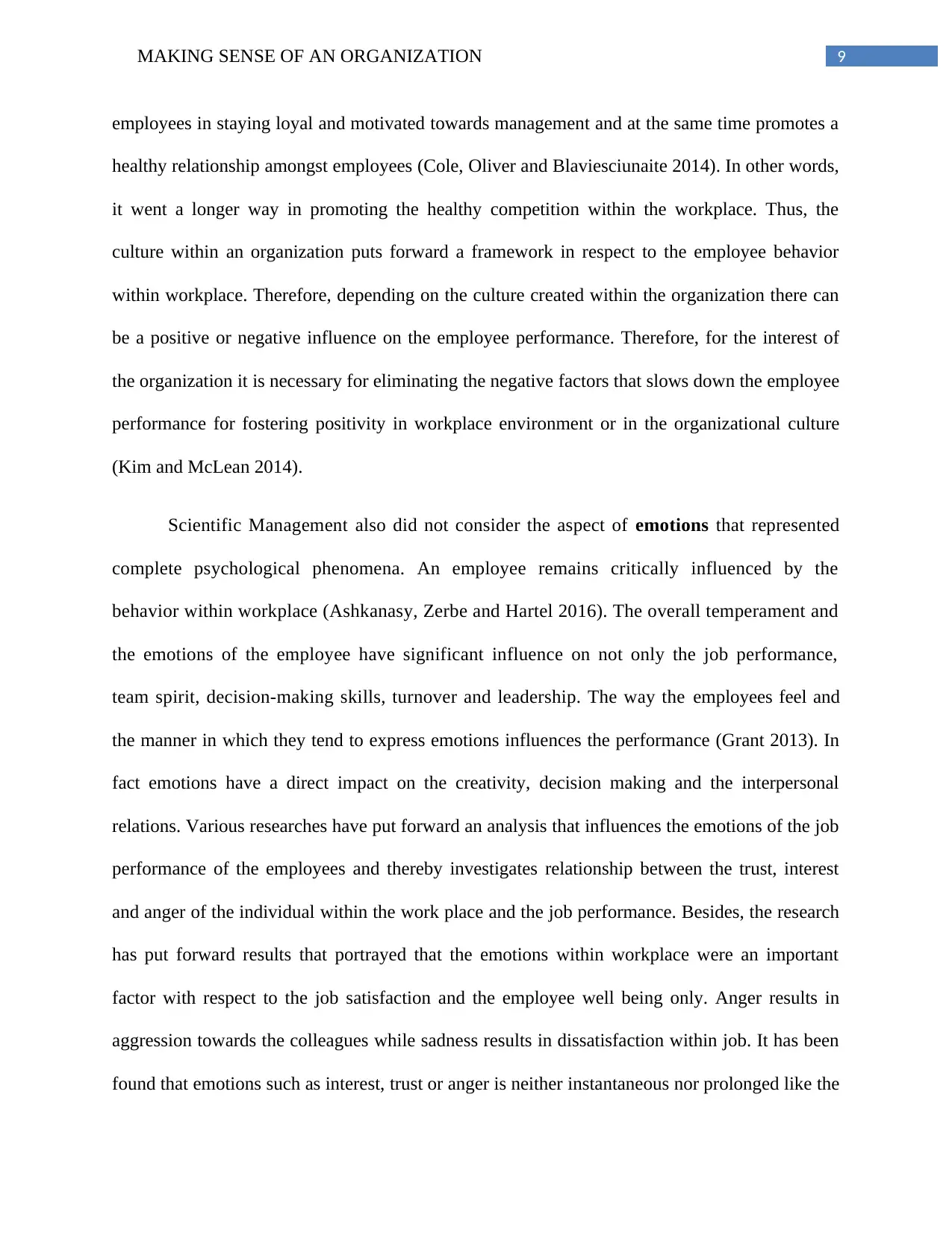
9MAKING SENSE OF AN ORGANIZATION
employees in staying loyal and motivated towards management and at the same time promotes a
healthy relationship amongst employees (Cole, Oliver and Blaviesciunaite 2014). In other words,
it went a longer way in promoting the healthy competition within the workplace. Thus, the
culture within an organization puts forward a framework in respect to the employee behavior
within workplace. Therefore, depending on the culture created within the organization there can
be a positive or negative influence on the employee performance. Therefore, for the interest of
the organization it is necessary for eliminating the negative factors that slows down the employee
performance for fostering positivity in workplace environment or in the organizational culture
(Kim and McLean 2014).
Scientific Management also did not consider the aspect of emotions that represented
complete psychological phenomena. An employee remains critically influenced by the
behavior within workplace (Ashkanasy, Zerbe and Hartel 2016). The overall temperament and
the emotions of the employee have significant influence on not only the job performance,
team spirit, decision-making skills, turnover and leadership. The way the employees feel and
the manner in which they tend to express emotions influences the performance (Grant 2013). In
fact emotions have a direct impact on the creativity, decision making and the interpersonal
relations. Various researches have put forward an analysis that influences the emotions of the job
performance of the employees and thereby investigates relationship between the trust, interest
and anger of the individual within the work place and the job performance. Besides, the research
has put forward results that portrayed that the emotions within workplace were an important
factor with respect to the job satisfaction and the employee well being only. Anger results in
aggression towards the colleagues while sadness results in dissatisfaction within job. It has been
found that emotions such as interest, trust or anger is neither instantaneous nor prolonged like the
employees in staying loyal and motivated towards management and at the same time promotes a
healthy relationship amongst employees (Cole, Oliver and Blaviesciunaite 2014). In other words,
it went a longer way in promoting the healthy competition within the workplace. Thus, the
culture within an organization puts forward a framework in respect to the employee behavior
within workplace. Therefore, depending on the culture created within the organization there can
be a positive or negative influence on the employee performance. Therefore, for the interest of
the organization it is necessary for eliminating the negative factors that slows down the employee
performance for fostering positivity in workplace environment or in the organizational culture
(Kim and McLean 2014).
Scientific Management also did not consider the aspect of emotions that represented
complete psychological phenomena. An employee remains critically influenced by the
behavior within workplace (Ashkanasy, Zerbe and Hartel 2016). The overall temperament and
the emotions of the employee have significant influence on not only the job performance,
team spirit, decision-making skills, turnover and leadership. The way the employees feel and
the manner in which they tend to express emotions influences the performance (Grant 2013). In
fact emotions have a direct impact on the creativity, decision making and the interpersonal
relations. Various researches have put forward an analysis that influences the emotions of the job
performance of the employees and thereby investigates relationship between the trust, interest
and anger of the individual within the work place and the job performance. Besides, the research
has put forward results that portrayed that the emotions within workplace were an important
factor with respect to the job satisfaction and the employee well being only. Anger results in
aggression towards the colleagues while sadness results in dissatisfaction within job. It has been
found that emotions such as interest, trust or anger is neither instantaneous nor prolonged like the
Paraphrase This Document
Need a fresh take? Get an instant paraphrase of this document with our AI Paraphraser
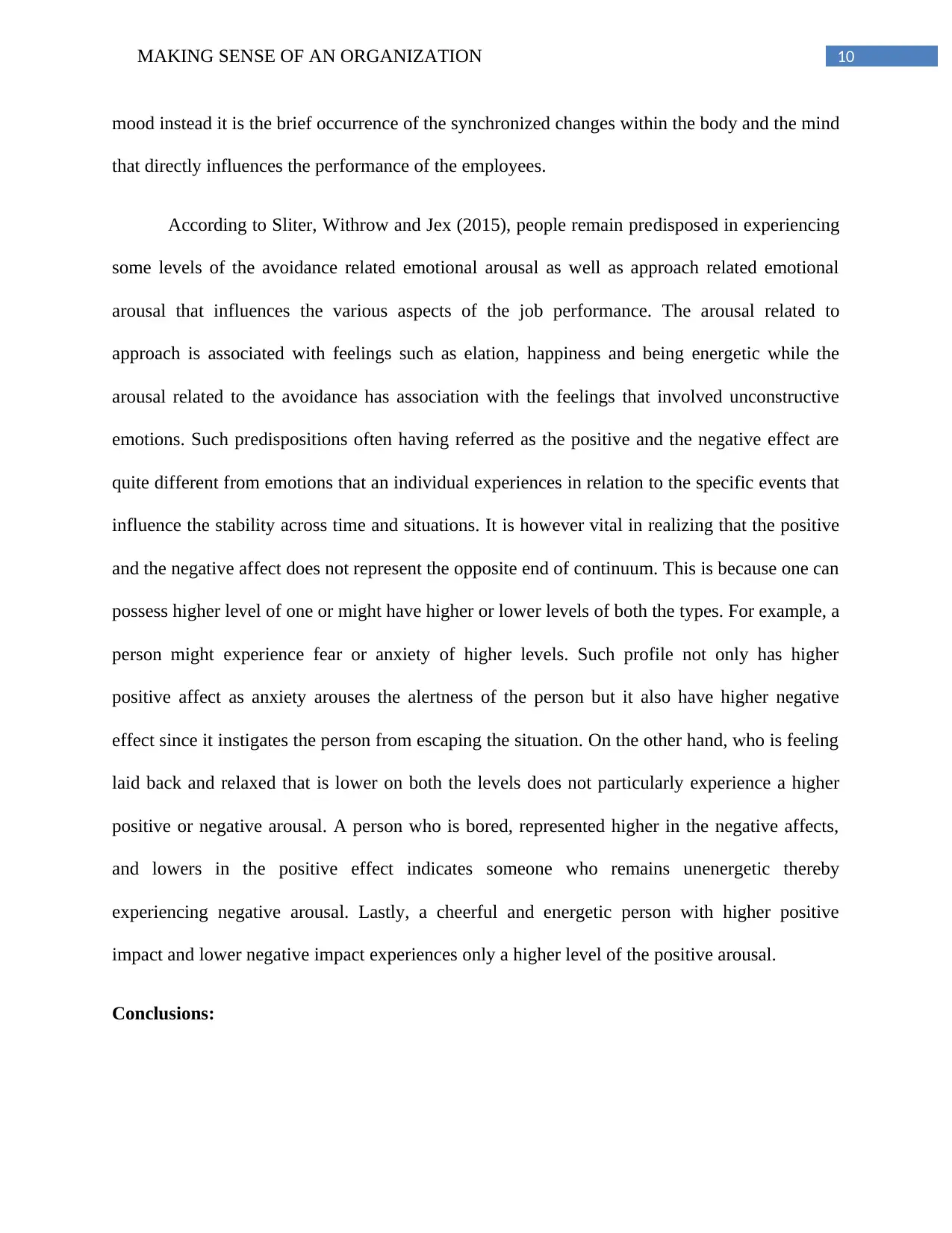
10MAKING SENSE OF AN ORGANIZATION
mood instead it is the brief occurrence of the synchronized changes within the body and the mind
that directly influences the performance of the employees.
According to Sliter, Withrow and Jex (2015), people remain predisposed in experiencing
some levels of the avoidance related emotional arousal as well as approach related emotional
arousal that influences the various aspects of the job performance. The arousal related to
approach is associated with feelings such as elation, happiness and being energetic while the
arousal related to the avoidance has association with the feelings that involved unconstructive
emotions. Such predispositions often having referred as the positive and the negative effect are
quite different from emotions that an individual experiences in relation to the specific events that
influence the stability across time and situations. It is however vital in realizing that the positive
and the negative affect does not represent the opposite end of continuum. This is because one can
possess higher level of one or might have higher or lower levels of both the types. For example, a
person might experience fear or anxiety of higher levels. Such profile not only has higher
positive affect as anxiety arouses the alertness of the person but it also have higher negative
effect since it instigates the person from escaping the situation. On the other hand, who is feeling
laid back and relaxed that is lower on both the levels does not particularly experience a higher
positive or negative arousal. A person who is bored, represented higher in the negative affects,
and lowers in the positive effect indicates someone who remains unenergetic thereby
experiencing negative arousal. Lastly, a cheerful and energetic person with higher positive
impact and lower negative impact experiences only a higher level of the positive arousal.
Conclusions:
mood instead it is the brief occurrence of the synchronized changes within the body and the mind
that directly influences the performance of the employees.
According to Sliter, Withrow and Jex (2015), people remain predisposed in experiencing
some levels of the avoidance related emotional arousal as well as approach related emotional
arousal that influences the various aspects of the job performance. The arousal related to
approach is associated with feelings such as elation, happiness and being energetic while the
arousal related to the avoidance has association with the feelings that involved unconstructive
emotions. Such predispositions often having referred as the positive and the negative effect are
quite different from emotions that an individual experiences in relation to the specific events that
influence the stability across time and situations. It is however vital in realizing that the positive
and the negative affect does not represent the opposite end of continuum. This is because one can
possess higher level of one or might have higher or lower levels of both the types. For example, a
person might experience fear or anxiety of higher levels. Such profile not only has higher
positive affect as anxiety arouses the alertness of the person but it also have higher negative
effect since it instigates the person from escaping the situation. On the other hand, who is feeling
laid back and relaxed that is lower on both the levels does not particularly experience a higher
positive or negative arousal. A person who is bored, represented higher in the negative affects,
and lowers in the positive effect indicates someone who remains unenergetic thereby
experiencing negative arousal. Lastly, a cheerful and energetic person with higher positive
impact and lower negative impact experiences only a higher level of the positive arousal.
Conclusions:
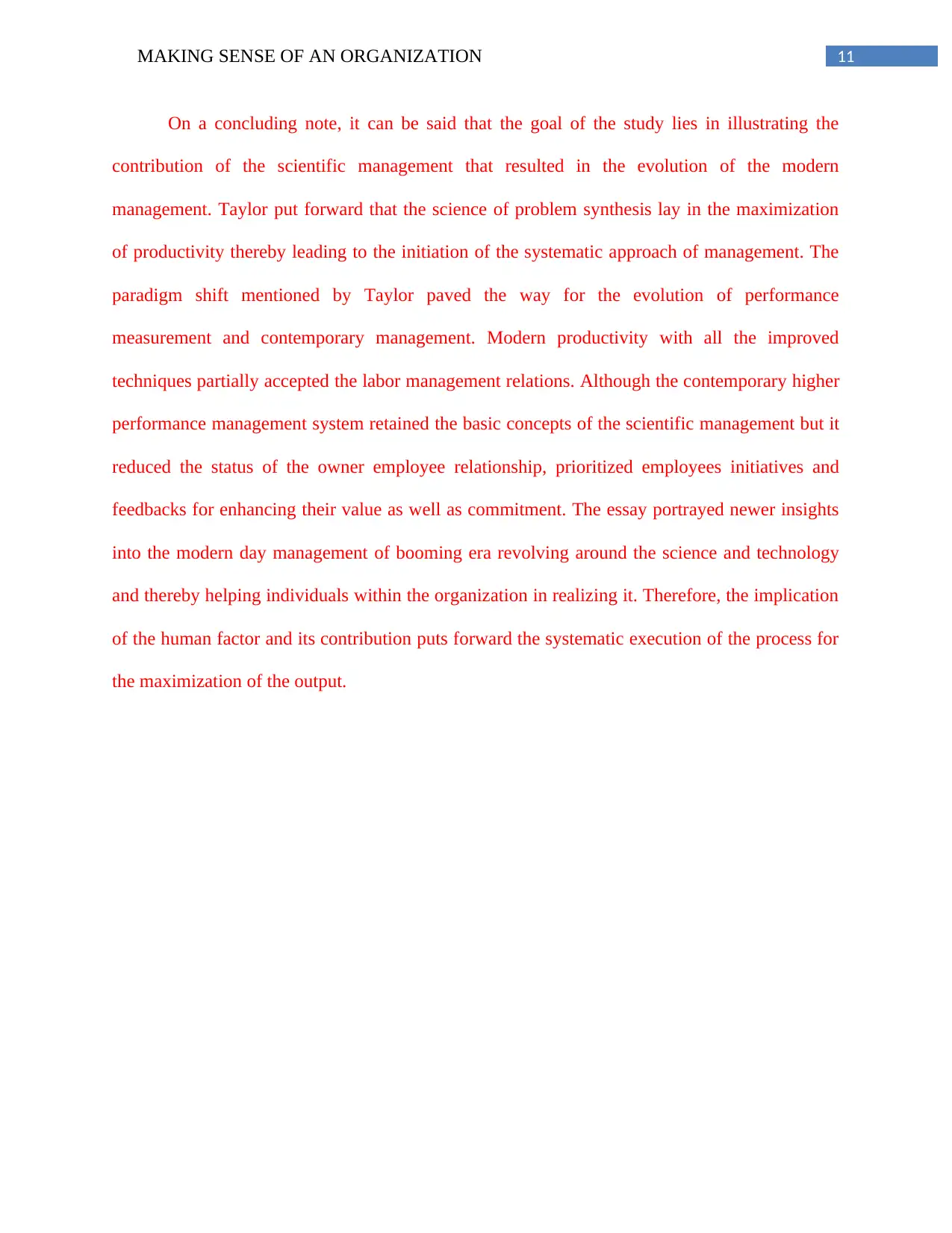
11MAKING SENSE OF AN ORGANIZATION
On a concluding note, it can be said that the goal of the study lies in illustrating the
contribution of the scientific management that resulted in the evolution of the modern
management. Taylor put forward that the science of problem synthesis lay in the maximization
of productivity thereby leading to the initiation of the systematic approach of management. The
paradigm shift mentioned by Taylor paved the way for the evolution of performance
measurement and contemporary management. Modern productivity with all the improved
techniques partially accepted the labor management relations. Although the contemporary higher
performance management system retained the basic concepts of the scientific management but it
reduced the status of the owner employee relationship, prioritized employees initiatives and
feedbacks for enhancing their value as well as commitment. The essay portrayed newer insights
into the modern day management of booming era revolving around the science and technology
and thereby helping individuals within the organization in realizing it. Therefore, the implication
of the human factor and its contribution puts forward the systematic execution of the process for
the maximization of the output.
On a concluding note, it can be said that the goal of the study lies in illustrating the
contribution of the scientific management that resulted in the evolution of the modern
management. Taylor put forward that the science of problem synthesis lay in the maximization
of productivity thereby leading to the initiation of the systematic approach of management. The
paradigm shift mentioned by Taylor paved the way for the evolution of performance
measurement and contemporary management. Modern productivity with all the improved
techniques partially accepted the labor management relations. Although the contemporary higher
performance management system retained the basic concepts of the scientific management but it
reduced the status of the owner employee relationship, prioritized employees initiatives and
feedbacks for enhancing their value as well as commitment. The essay portrayed newer insights
into the modern day management of booming era revolving around the science and technology
and thereby helping individuals within the organization in realizing it. Therefore, the implication
of the human factor and its contribution puts forward the systematic execution of the process for
the maximization of the output.
⊘ This is a preview!⊘
Do you want full access?
Subscribe today to unlock all pages.

Trusted by 1+ million students worldwide
1 out of 16
Related Documents
Your All-in-One AI-Powered Toolkit for Academic Success.
+13062052269
info@desklib.com
Available 24*7 on WhatsApp / Email
![[object Object]](/_next/static/media/star-bottom.7253800d.svg)
Unlock your academic potential
Copyright © 2020–2025 A2Z Services. All Rights Reserved. Developed and managed by ZUCOL.




